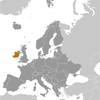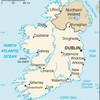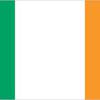Ireland [+]Compare [E]dit [H]istory
Aliases: EireObject «Ireland» was created due to
Add new object to «Ireland» or move existing objects here.
Object «Ireland» has attributes [Show empty attributes][Hide empty attributes]
| Attribute | Value |
|---|---|
| Geography | |
| Area | 70,273 km² |
| Continent | Europe |
| Land area | 68,883 km² |
| Water area | 1,390 km² |
| Land boundaries | 490 km |
| Border countries |
|
| Coastline | 1,448 km |
| Mean elevation | 118 m |
| Lowest point | 0 m |
| Highest point | 1,041 m |
| People | |
| Population | 5,176,569 |
| Official languages |
|
| Religion | Roman Catholic |
| Government | |
| Long country name | Add |
| Short country name | Ireland |
| Long local name | Add |
| Short local name | Eire |
| Former name | Add |
| Government type | Parliamentary republic |
| Capital | Dublin |
| Economy | |
| GDP (PPP) | 353,300,000,000 USD |
| GDP (OER) | 331,500,000,000 USD |
| GDP (real growth rate) | 7.2 % |
| GDP - per capita (PPP) | 73,200 USD |
| Gross national saving | 33.1 % of GDP |
| Labor force | 2,226,000 |
| Unemployment rate | 6.7 % |
| Population below poverty line | 8.2 % |
| Budget revenues | 86,040,000,000 USD |
| Budget expenditures | 87,190,000,000 USD |
| Military expenditures | 0.33 % of GDP |
| Taxes and other revenues | 26 % of GDP |
| Budget surplus or deficit | -0.3 % of GDP |
| Public debt | 68.6 % of GDP |
| Inflation rate | 0.3 % |
| Central bank discount rate | 0.05 % |
| Commercial bank prime lending rate | 4.08 % |
| Stock of narrow money | 191,900,000,000 USD |
| Stock of broad money | 191,900,000,000 USD |
| Stock of domestic credit | 299,100,000,000 USD |
| Market value of publicly traded shares | 128,000,000,000 USD |
| Current account balance | 28,140,000,000 USD |
| Exports | 219,700,000,000 USD |
| Imports | 98,130,000,000 USD |
| Reserves of foreign exchange and gold | 4,412,000,000 USD |
| External debt | 2,470,000,000,000 USD |
| National currency | euros |
| National currency (code) | EUR |
| National currency (symbol) | € |
| National currency rate to USD | 0.885 |
Celtic tribes arrived on the island between 600 and 150 B.C. Invasions by Norsemen that began in the late 8th century were finally ended when King Brian BORU defeated the Danes in 1014. Norman invasions began in the 12th century and set off more than seven centuries of Anglo-Irish struggle marked by fierce rebellions and harsh repressions. The Irish famine of the mid-19th century was responsible for a drop in the island's population by more than one quarter through starvation, disease, and emigration. For more than a century afterward, the population of the island continued to fall only to begin growing again in the 1960s. Over the last 50 years, Ireland's high birthrate has made it demographically one of the youngest populations in the EU.The modern Irish state traces its origins to the failed 1916 Easter Monday Uprising that touched off several years of guerrilla warfare resulting in independence from the UK in 1921 for 26 southern counties; six northern (Ulster) counties remained part of the UK. Deep sectarian divides between the Catholic and Protestant populations and systemic discrimination in Northern Ireland erupted into years of violence known as the "Troubles" that began in the 1960s. The Government of Ireland was part of a process along with the UK and US Governments that helped broker the Good Friday Agreement in Northern Ireland in 1998. This initiated a new phase of cooperation between the Irish and British Governments. Ireland was neutral in World War II and continues its policy of military neutrality. Ireland joined the European Community in 1973 and the euro-zone currency union in 1999. The economic boom years of the Celtic Tiger (1995-2007) saw rapid economic growth, which came to an abrupt end in 2008 with the meltdown of the Irish banking system. Today the economy is recovering, fueled by large and growing foreign direct investment, especially from US multi-nationals.
Similar objects
- [⇄] [+] Cyprus
- [⇄] [+] Luxembourg
- [⇄] [+] Malta
- [⇄] [+] Netherlands
- [⇄] [+] United Kingdom
Most often compared with
- [⇄] [+] Malta
- [⇄] [+] Netherlands
- [⇄] [+] Luxembourg
- [⇄] [+] Palau
- [⇄] [+] United Kingdom
Everyone can something to edit or add.
There was one edit, no edits waiting approval. Last edited by everette34(9367), Sep 16, 2019 (59 fields were changed)
Help · Contact us · Disclaimer · Contributors · Developers · Donate


